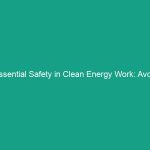Good Morning Team!
Today, we’re going to talk about something that should be on all our minds every day: working safely. Our topic is “Top Five Reasons to Work Safely Today: Must-Know Tips for HSE Success.” Safety is not just a priority; it’s a responsibility we all share. By the end of this Toolbox Talk, you will not only understand why working safely is crucial but also how you can implement these practices in your daily routine.
Understanding the Importance of Working Safely
So, what does it mean to work safely? At its core, working safely refers to the practices and protocols that aim to prevent accidents, injuries, and health issues in the workplace. It includes everything from wearing Personal Protective Equipment (PPE) to following proper Procedures when handling machinery.
Each of us plays a vital role in ensuring a safe work Environment. Ignoring Safety protocols can lead to severe consequences, not only for ourselves but also for our colleagues. Misconceptions about Safety often stem from a lack of understanding or complacency. For instance, some may think, “It won’t happen to me,” but the truth is, accidents can occur when least expected.
Key Hazards, Risks, and Safety Considerations
Let’s dive into the common Hazards we face in our work environment:
- Slips, Trips, and Falls: These are among the most common workplace injuries. Wet floors, uneven surfaces, and cluttered walkways can all lead to accidents.
- Machinery and Equipment: Improper use of machinery can result in severe injuries. Always ensure that you are trained and authorized to use any equipment.
- Hazardous Materials: Chemicals and other hazardous substances must be handled with care. Know the Material Safety Data Sheets (MSDS) and wear appropriate PPE.
- Manual Handling: Lifting heavy objects incorrectly can lead to musculoskeletal injuries. Always assess the load and seek help when needed.
- Workplace Violence: This can manifest as bullying, harassment, or physical threats. It’s essential to maintain a respectful workplace and report any incidents.
Ignoring these risks can lead to significant injuries, loss of productivity, and even legal ramifications for the company. We must all work together to mitigate these hazards.
Best Practices, Procedures, & Actionable Advice
Here are some practical tips to help you work safely:
- Wear Your PPE: Always wear the required Personal Protective Equipment. This includes helmets, gloves, Safety Goggles, and steel-toed boots. Remember, PPE is your first line of defense.
- Follow Safety Procedures: Adhere to all safety protocols established at our workplace. If you’re unsure about a procedure, ask your supervisor for clarification.
- Keep Workspaces Clean: A tidy workspace minimizes the risk of slips and trips. Ensure that all walkways are clear and that tools are put away after use.
- Report Hazards: If you notice anything unsafe, report it immediately. Don’t assume someone else will take care of it. Your vigilance can prevent accidents.
- Participate in Safety Training: Engage in all safety training sessions. These sessions are designed to equip you with the knowledge and skills to stay safe.
For example, let’s consider a case where an employee ignored the safety procedures while operating a forklift. They were not wearing a seatbelt and suddenly hit a bump, leading to a serious injury. This incident could have been avoided if safety protocols had been followed.
Regulations, Standards, and Compliance
Understanding Workplace Safety regulations is crucial. The Occupational Safety and Health Administration (OSHA) sets and enforces protective Workplace Safety and health Standards. Compliance with these standards is not optional; it’s a legal requirement designed to protect all employees.
In addition to federal Regulations, your company may have its own standards that you must adhere to. Compliance is essential not only for legal reasons but also for creating a culture of safety. Remember, a safe workplace is a productive workplace!
Employee Engagement & Discussion
Now that we’ve covered the importance of safety and Best Practices, let’s open the floor for discussion. Here are a few questions to ponder:
- What safety challenges have you encountered in your daily tasks?
- How can we improve our safety practices as a team?
- Have you ever witnessed a near-miss incident? What can we learn from it?
Your feedback is invaluable. Sharing experiences can help us all learn and grow in our safety practices.
Conclusion & Key Takeaways
In summary, working safely is crucial for our well-being and that of our colleagues. Remember these key takeaways:
- Understand the importance of safety in your daily tasks.
- Be aware of common hazards and take proactive measures to mitigate them.
- Follow safety procedures and wear your PPE at all times.
- Stay informed about regulations and compliance standards.
- Engage in open discussions about safety with your peers.
Let’s commit to prioritizing safety every single day. Thank you for your attention today, and thank you for being dedicated to creating a safe workplace. Your commitment makes a difference!


